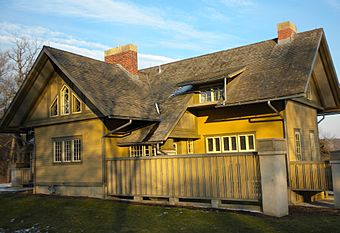Fabyan Villa facts for kids
Quick facts for kids |
|
|
Fabyan Villa
|
|
 |
|
| Location | Geneva, Illinois |
|---|---|
| Built | 1907 |
| Architect | Frank Lloyd Wright |
| Architectural style | Prairie School |
| NRHP reference No. | 84001128 |
| Added to NRHP | February 9, 1984 |
The Fabyan Villa was the home of a wealthy couple, George and Nelle Fabyan, from about 1908 to 1939. The house is famous because it was redesigned in 1907 by the well-known architect Frank Lloyd Wright. It was the main house on the Fabyans' large country property, which they called Riverbank.
Today, the house is a museum. The Fabyan Villa Museum shows visitors what the Fabyans' life was like. You can see photographs, items they collected, and some of their original furniture.
Contents
The Amazing Riverbank Estate
George Fabyan was a millionaire businessman who was very curious and loved to learn new things. He and his wife, Nelle, used money he inherited to create their dream estate, Riverbank. This huge property in Geneva, Illinois, was about 300 acres. It was like a private park with many amazing features.
Riverbank had a beautiful Japanese Garden, a private zoo, and a swimming pool designed to look like ancient Roman baths. It also had greenhouses for growing plants, a lighthouse, and even a Dutch-style windmill.
A Frank Lloyd Wright House
In 1905, the Fabyans bought a farmhouse that was built in the mid-1800s. They called it The Villa. Two years later, they hired Frank Lloyd Wright to completely change it. Wright was famous for his Prairie School style of architecture, which used horizontal lines to look like the flat prairie landscape.
Wright added a new wing and three large porches to the house. He also included some of his signature ideas, like:
- Windows with geometric patterns.
- Long rows of windows called "light screens" to let in lots of natural light.
- An open floor plan, making the inside feel spacious.
The Japanese Garden
In 1910, the Fabyans hired a designer named Taro Otsuka to create a Japanese-style garden on their land. These gardens were very fashionable at the time. For many years, a Japanese gardener named Susumu Kobayashi took care of it. The garden was a popular attraction for visitors in the 1920s and 1930s.
After the Fabyans were gone, the garden was neglected for a long time. But starting in 1974, it was restored. Today, it features a pond, a waterfall, a curved moon bridge, and a teahouse, just like it did long ago.
The Fabyan Windmill
In 1914, the Fabyans bought a large windmill from a nearby farm and moved it to their estate. The windmill was special because it had a bakery inside. According to a local story, the Fabyans used it to bake bread for their pet bears!
During World War I, food was rationed. The Fabyans used the windmill to grind grain for people in their community. The U.S. government later honored this good deed with a postage stamp.
Riverbank Laboratories: A Place for Science
Between 1912 and 1922, George Fabyan created Riverbank Laboratories. This was the first private research center in the United States. Fabyan was very interested in science and secret codes.
The Birthplace of Code-Breaking
The National Security Agency (NSA) calls Riverbank Laboratories the birthplace of American cryptology. Cryptology is the science of writing and solving secret codes. During World War I, almost all of the U.S. military's secret code work was done here.
A team led by Elizabeth Wells Gallup, including the famous code-breakers Elizebeth Friedman and William F. Friedman, worked at the labs. They were originally trying to find secret messages in Shakespeare's plays. They believed the messages were hidden by Sir Francis Bacon. This work helped them become experts in code-breaking.
A Lab for Sound
In 1918, Fabyan built the first "reverberation chamber" in the U.S. for a Harvard scientist named Wallace Clement Sabine. Sabine was a pioneer in architectural acoustics, which is the study of how sound behaves inside buildings. This special room was designed to study sound and echoes. The acoustics lab is still used for testing sound today.
See also
- List of Frank Lloyd Wright works



